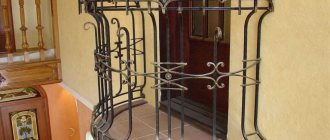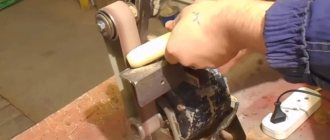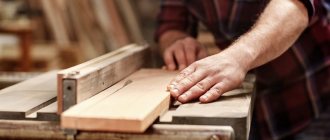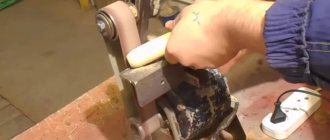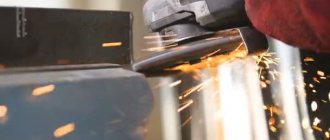Sheet metal products are characterized by complex surfaces and high demands on the accuracy of bending lines. Single parts - boxes, gutters or bottoms can be made manually, with certain skills in working with metal, of course. But for any small-scale production you will already need a sheet bending machine.
To choose the right sheet metal bending machine, you need to not only know what types of equipment exist, but also clearly define what operations you are going to perform and what metal you are going to work with. Not only the type of machine, but also its price depends on this. Like most metalworking equipment, a sheet metal bending machine is very expensive even for small businesses, not to mention private craftsmen.
Types of sheet benders
There are three types of sheet metal bending machines:
- Simple manual ones, in which metal bending occurs when force is applied in a certain place. These units make it possible to bend sheet material in a straight line at any angle - from a few degrees to almost 360°.
For bending sheet metal
To obtain radial bending of a metal sheet
All these devices are classified as sheet bending machines. The easiest way to make one with your own hands is the unit of the first group, a little more difficult - the third (rollers for sheet metal). So we’ll talk about them - from how to make a sheet bending machine with your own hands.
Machine drive
Machines for bending sheet steel can be divided into:
- manual;
- electromechanical;
- hydraulic;
- pneumatic;
- mechanical:
- electromagnetic sheet benders.
They differ in productivity and parameters of the metal being processed. If you need bending equipment at home or in a small metalworking shop, where it is not used every day and is intended for auxiliary work, then it is best to buy or make your own manual sheet bending machine. It copes well with metal up to 1.2 mm thick and is capable of bending at an angle of up to 1200; some modifications have the ability to bend edges up to 1800.
Industrial sheet bending equipment must have a drive. Most machines for large-scale production use hydraulics - such machines work quickly, silently and have advanced functionality that allows you to produce not only parts with parallel bending lines, but also segmented ones. The hydraulic machine for bending sheet metal is distinguished by its extraordinary smoothness of operation and high productivity. This allows you to work not only with large sheet thicknesses, but also with high accuracy, down to fractions of a degree.
Pneumatic bending industrial equipment is equal in power and performance to hydraulic equipment, but is harsher in operation and is somewhat noisy. It is more difficult to regulate the force on the sheet, but in large-scale production, pneumatics, especially when using CNC, show maximum productivity.
Electrical, mechanical and electromechanical drives are typical for medium-performance equipment. Such a metal bending machine can work for an entire shift and produce a sufficient number of parts of a rather complex configuration. In this case, reconfiguration to another type of product occurs within a few minutes. Mechanical and electromechanical sheet benders can be produced either in a stationary version and work in a workshop, or in a mobile form for use directly on site. For example, when installing a metal roof or a highly complex drainage system.
Most mid-range machines work well on painted metal without damaging the surface. They can be used to process galvanized metal sheets or corrugated sheets coated with polyurethane or other polymers. Sheet benders for corrugated sheets can be purchased manually, to produce 200-300 sheets of standard size, or in the form of complex industrial equipment with roller forming shafts.
Simple manual
Shaped metal parts cost a lot of money. Even more than corrugated sheeting or metal tiles, therefore it makes sense to make a simple machine for bending sheet metal, and with its help make as many corners, ebbs and other similar parts as you need, and exclusively to your own dimensions.
If you're worried about appearance, you shouldn't be. On sale today there is sheet metal not only galvanized, but also painted. In all designs, the sheet is fixed tightly, so that when working it does not slide on the table, which means that the paint does not rub off or get scratched. It is also not damaged in places of bending. So the products will look quite decent. If you try, they will look even better than what they sell on the market.
Powerful sheet bending machine from brands
This sheet bending machine will require a flat surface (table), preferably metal, three corners with a shelf width of at least 45 mm, and a metal thickness of at least 3 mm. If you plan to bend long workpieces (more than a meter), it is advisable to take wider shelves and thicker metal. You can use brands, but this is for bending metal sheets of large thickness and length.
You will also need metal door hinges (two pieces), two large diameter screws (10-20 mm), wings on them, and a spring. You will also need a welding machine - weld the hinges and make holes (or a drill with a metal drill bit).
For a homemade sheet bender, a 70 mm brand was used - three pieces of 2.5 m each, two bolts of 20 mm in diameter, a small piece of metal 5 mm thick (for cutting jibs), a spring. Here's the procedure:
- Two brands are folded, and grooves are cut into them at both ends for hinges. The edges of the recesses are beveled at 45°. The third tee is cut in the same way, only the depth of the recess is made a little larger - this will be the clamping bar, so it should move freely.
Cutting notches for hinges
Boil the loops well
Weld pieces of reinforcement to the bolt head
Homemade sheet bender in progress
This option is very powerful - you can bend long workpieces and sheets of considerable thickness. Such scales are not always in demand, but they can always be reduced. The video suggests a similar design of a smaller size, but with a different fastening of the clamping bar. By the way, no one bothers you to also install a spring on the screw - it will be easier to raise the bar. What’s interesting about this design is that you can make beading on it, something that such devices usually cannot do.
From a corner with a different type of clamping bar
This model is welded from a thick-walled angle, the frame is made like an ordinary construction sawhorse, which is welded from the same angle. The handle is from a luggage trolley. The design of the screws is interesting - they are long, the handle is curved in the shape of the letter “L”. Convenient to unscrew/screw.
Small manual sheet bender for DIY production
This homemade sheet metal bending machine has many features:
- The corners are not arranged with shelves facing each other, but are directed in one direction. Because of this, attaching the loop is not the most convenient, but it can be done.
Classification of machines by bending method
Metal sheets can be bent in different ways. All sheet metal bending machines can be classified into three main groups:
- press;
- rotary;
- rotary.
Industrial bending equipment, in most cases, belongs to the first type. Hydraulic and pneumatic presses are very productive and are capable of performing a wide range of operations, in addition to the actual sheet bending, they can perforate metal and produce stamped parts.
For small-scale production, electromechanical and mechanical presses are used, where rotation shafts and crank mechanisms are used for drive.
Depending on the shape of the punch and matrix, which are easy to replace, parts of a certain configuration are obtained. As a rule, presses bend sheet steel no more than 900, but with high productivity, their use brings a significant economic effect.
Main parts of the press:
- bed;
- drive unit;
- vertically moving traverse;
- punch;
- matrix;
- base deflection compensation device;
- management, control and measurement mechanisms;
- clamps for holding the sheet;
- knife for horizontal cutting of workpieces.
Diagram of the main parts of the press brake
A sheet bending machine with a rotary mechanism is one of the most convenient. A mechanical sheet bender can work with steel up to 1.5 mm thick, stainless steel, non-ferrous metals of all types without preheating. The role of the working mechanism is performed by a rotating beam fixed in the front part of the table in a horizontal position at table level.
The sheet is placed on a horizontal table and pressed against a fixed beam. The front edge of the beam is located at an obtuse angle to the plane of the table (measured from the outside). It is this slope that determines the bending angle of the sheet. Usually it is 90-1200. After securing the sheet, the rotary beam rises and bends the metal along the entire line. The dimensions of the workpiece depend only on the width of the work table. This device for bending sheet metal is characterized by its simple design, high productivity and mobility. In addition, using the drawings of factory-made machines, you can build a sheet bending machine yourself, increasing or decreasing the main dimensions according to your needs.
Sheet metal rollers or roller bender
This type of sheet bending machine can have three types of drive:
They make rollers for sheet metal with manual or electric drive with their own hands. Manual ones have 3 shafts, electric ones can have 3-4, but usually there are also three.
This machine needs a good solid foundation. This could be a separate bed or some kind of workbench or table. The basis of the structure is rolls. They are made the same size. The two lower ones are installed permanently, the upper one is movable, so that in the lower position it is located between the rollers. By changing the distance between the lower rollers and the upper one, the radius of curvature changes.
The machine is set in motion using a handle attached to one of the shafts. Then the torque is transmitted to other rollers through sprockets. They are selected so that the rotation speed is the same.
If the equipment is intended to produce pipes, the upper roller on one side is made removable, with a quick fixation system. Once the sheet is rolled into a pipe, there is no other way to pull it out.
Hello dear friends, this video offers a number of practical tips on how to replace the threshold and install a car. The auto mechanic shares his practical experience, which has been accumulated over the years, and now you can use those techniques and techniques that he considers necessary to replace the threshold.
Using the example of a car for threshold repair, you can see that the threshold is completely rotten. Where to begin. You can buy a new one on the market, but there are usually very thin thresholds on sale there. But this part of the car should still be strong, taking into account, for example, bumps in the countryside. Therefore, the master advises ordering its production from thicker metal, for example 1.2 mm, at the factory or in any workshop where there is a specialist. If the car is running, you can go to a specialist, he will take measurements.
If the car is not running, we will consider how to take measurements and submit this measurement to the factory. Let's start in order. First you need to look at how the threshold has rotted. In this case, we see that only the lower part has rotted. We look carefully at where the paint has bulged. If this is the only problem, you need to change the above swollen paint. In this case, the openings are kept intact, so you should not spoil the car with unnecessary alterations. This threshold in this case, as one of the options, can be replaced from the bottom to the level of the collar. But in this case you will have to putty, and it will all be in a visible place. The master’s advice is to replace the threshold in the corner that he indicates. When it fits well and is welded neatly, all that remains is to putty, coat, and clean.
How to take measurements? To take measurements, take any wire and bend it around the top. When you go around, you can rest assured that the size will not go away. The end will be the same. We bend it tightly, you need to have good pliers. We copy all the protrusions and zigzags. We bend the corners and repeat all the radii. A good specialist at the factory will repeat these radii and zigzags. You need to add 3mm air for tightening. If you do not do this, it may turn out that the threshold will not fit and will cling. If the thresholds are slanting, we take two measurements. One at the beginning, the second at the end. If curved, then additionally in the middle.
More about the most useful tool for car repairs here.
Nowadays, thresholds on cars are an element of the body structure. Their location on the car body is not entirely advantageous, since they are constantly susceptible to the influence of water, various solutions that are used to pour on the road, and very often dents form on them due to stones flying from under the wheels of the car. Long-term observations and experiments have shown that car thresholds can be restored. In addition, they can be repaired without contacting special companies, but with your own hands.
Scope of use of sheet bending equipment
As a rule, companies and organizations decide to buy a manual sheet bending machine if they often have to perform various types of work related to metal processing, for example, in the manufacture of roofing elements (ebbins, valleys, aprons). A simple and mobile sheet bending machine is an effective tool used for sheet metal when forming individual parts from it. The price of a Russian-made manual bending machine in Moscow and throughout Russia starts from 60 thousand rubles, which allows even a small enterprise to buy this equipment at a low cost.
Buying a manual bending machine for sheet metal is beneficial for any enterprise engaged in processing rolled metal. Thanks to Russian-made manual sheet benders with a cutting machine, it is possible to produce workpieces of various shapes and sizes, while the maximum width of the processed workpiece depends on the specific model and can reach 110 - 120 cm or more, and the thickness of the rolled metal does not exceed 6 mm.
The cost of a manual sheet metal bending machine is quite reasonable. Therefore, both large companies and small firms can buy manual sheet bending machines at competitive prices.
What are car thresholds made of and what are they intended for?
Thresholds for vehicles are divided into several types. The difference between them is how they are attached to the vehicle and what exactly they are intended for.
Let us examine in detail what types of thresholds for cars there are.
- Fixed. Such thresholds are attached by welding and form an integral body structure. She looks tougher.
- Removable. Unlike non-removable ones, these thresholds are attached to the lower parts of the vehicle body using self-tapping screws or special bolts. They can be either protective or as an additional step.
- Power thresholds are installed on frame SUVs. They are attached to the frame by welding or using special powerful bolts and nuts. This power structure will be much larger than the thresholds on cars that have a monocoque body.
Manufacturing of thresholds for cars
Removable thresholds, which were made in factories or special companies, are in most cases located in vehicle interiors. They are called the top of the thresholds.
It is this part that gets most contaminated when passengers get into or out of the car.
If something impacts the body, then the upper part of the sills is susceptible to mechanical damage.
The lower parts of the vehicle sills are also removable; they are located outside the car.
Removable thresholds for protection are installed by car owners so that they can protect the main structures from various damages: dirt, chemicals, and cracks.
On the Internet you will find many videos on the topic of how to make thresholds for a car with your own hands.
The manufacture of thresholds for cars, as well as their repair, can be done independently, without turning to specialists for help and without spending extra savings. The threshold structure is quite easy to remove. To do this job, there is no need to use welding. It will be enough to prepare straightening or hood. If all the work on repairing thresholds is done extremely carefully, then you will not need to paint the structure. The protective sills are removable parts, but still, this is considered a body repair.
To repair car thresholds, you need to prepare:
- Workbench;
- anvils;
- mallet, as well as everything for straightening.
If there is a dent on the threshold, it must be removed without much effort, as it can damage the structure of the metal and also damage the paintwork. It happens that corrosion begins to corrode the metal of the threshold. In this case, it is necessary to correctly assess the extent of the damage.
If the damage is minor, then you can simply cut out the part with the flaw and weld another one.
But it happens that corrosion has damaged most of it, then it is better to install a new structure.
How to repair a rotten threshold on a car
Fixed thresholds can also be damaged. This could be a dent or corrosion if the car was used in poor conditions. If a vehicle is constantly in contact with water, dirt or chemicals found on our roads, then naturally the sills will be corroded. When the car is also poorly painted, problems with the wear of the thresholds may arise much earlier than we would like. In most cases, this applies to domestic cars.
Sometimes a dent can be made with your own hands, without any stones. This is elementary; it will be enough to install the jack incorrectly to change the wheel.
To start repairing body sills yourself, you first need to assess how damaged they are. This will make it possible to choose the right tools for future work.
Each car owner can handle minor damage to the body himself.
If you confidently decide to do the repairs yourself, you will need:
- Workbench;
- welding;
- hood;
- several anvils;
- Bulgarian;
- tools for a locksmith.
In order to remove dents or other minor misalignments without damaging the paint on the parts, you will need to make surface repairs using an extractor or plotter. If the dent still remains, you should try to repair it by welding. A rectangular hole is cut out from the side of the threshold. They insert an anvil into it and try to carefully straighten out the dent. When your car has more serious damage, metal will have to be cut out in several places. Then the holes are hidden using patches.
If the thresholds are damaged by corrosion, the damaged area is cut out with a grinder, a pattern is made, a patch is cut out from it, which is then welded.
Step-by-step manufacturing instructions
To make a traverse sheet bender we will need:
- 4 meters of steel angle, side – 50 mm;
- Ball joint for car, with mounting bracket;
- The stabilizer rod is from the same, with a diameter of 10 mm;
- Grinder, drill, electric welding.
- We cut the rolled metal into pieces of 1 meter with a grinder. If there is a need to work with metal of a larger width, the length of the corners increases. At least 100 mm must be added to the width of the working surface.
- Using an angle grinder, we cut out two eyes from the ball joint bracket. These will be the working loops of the movable traverse.
- From the stabilizer strut we make an axis on which the hinges will rest.
Making a bed for a sheet bender
We weld the fourth corner to the lower fixed cross-beam on both sides for strength. We drill holes in the frame. The entire structure must be fixed on a stable surface, for example, on a steel workbench.
We screw the sheet bender to the workbench and check the free movement of the movable traverse.
The design allows you to work with iron sheets up to 2 mm thick and 92 cm wide. Bend angles can be selected to any size; the workpiece can be bent either in one direction or in steps.
When working with a thick workpiece, the handle is extended with a metal pipe; the strength of the angle is always sufficient. Working with standard galvanized sheeting is not difficult; the device bends it with the ease of cardboard.
Roller benders
One of the most productive and progressive tools for bending sheet metal up to 1 mm thick is a roller bender.
After watching the video, you can get an idea of how it works. Roller sheet bending is produced in stationary, mobile and manual versions. In the last two cases, the maximum thickness of the sheet that can be bent without much effort is 0.8 mm. The stationary roller bender can work with metal up to 1 mm thick and up to 2.04 m wide.
In all versions of the sheet bender, the largest angle of inclination of the edges is 900. But this is not a particular obstacle to its use - large angles for boxes or additional elements are rarely needed, and it is not difficult to bend the edges with a seam connection.
Based on roller technology, you can buy or build yourself a small tabletop sheet bender for making various crafts necessary for home repairs or building a garage or cottage. It can also be used for body repairs in private workshops, service stations or in your own garage. A roller mini-sheet bender will become a reliable assistant in the installation of roofs, gutters, edgings, and window sills.
Temporary structure according to a simplified scheme
The considered version of the sheet bender is made for regular work, and is actually a stationary device. If you urgently need to do one-time work on making tin products, you can create a simpler device.
For production you will need:
- Three corners 40-50 mm, width according to your needs;
- A pair of door hinges;
- Two powerful clamps;
- Two rods (circles) as handles.
The two corners are fastened together with loops as tightly as possible.
The third, shorter corner, using clamps, presses the workpiece and the lower crossbeam to the workbench. This machine is not very convenient, but this is compensated by its ease of manufacture. The manufacturing option is up to you to choose.
Design features and operating principle
In installations of this type, a simple method of cold bending of a metal sheet is used.
The design of the sheet bending device is represented by a lever mechanism; the operation of the bending equipment is carried out due to the muscular effort of the operator.
The metal sheet is fixed on the work table using a clamping beam. Then, using a rotating beam, the operator bends the workpiece to the appropriate angle.
Manual sheet bending machines with a cutting machine, which can be purchased complete with bending equipment at a low price, allow you to cut flat blanks from metal sheets.
A simple solution for sheet bending
This homemade sheet bender can be made in 30-60 minutes.
Minimum amount of materials required:
- Corner No. 5 1.5 meters long.
- Channel No. 18 - 20, as a bed. Length 1.5 - 2m.
- Water pipe 2-3 m, for making a handle
- two door hinges, preferably garage ones.
How to assemble the structure can be seen from the attached photographs. The machine is simple but effective, unless, of course, you require special precision for bending sheets.
Pay attention to the dimensions of the sheets you are going to bend. It is necessary to weld the hinges with a reserve. Add 20-30 cm to the width of the sheet so that the sheet fits freely between the loops, make markings and safely weld.


